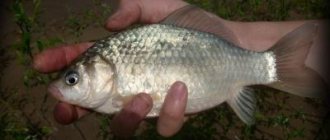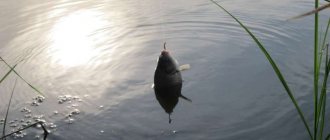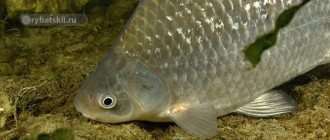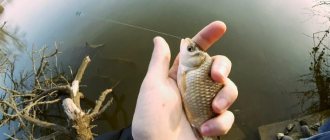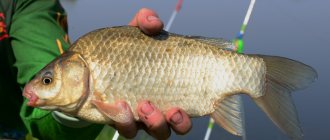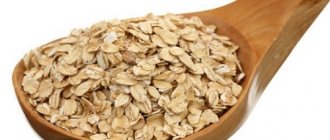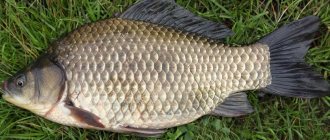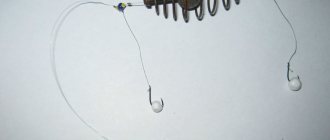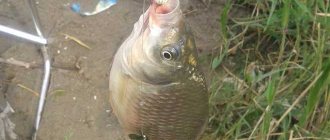Feeder rods began to appear on sale en masse in Russia in the late 90s and immediately became popular among bottom fishing adherents. The main advantage of the feeder - trouble-free long-distance and accurate casting - was immediately appreciated by those who had previously used a simple donk or a donk with an elastic band. Well, the use of feeders in combination with quivertip tips has brought crucian carp fishing to a fundamentally new level.
Large crucian carp do not gather in schools and live in a certain territory, leaving it only during spawning or some natural disasters. As a rule, these are snagged areas, thickets of coastal bushes and reeds, from which crucian carp come out to feed, so that at the slightest danger they can hide in the labyrinth of roots. In such conditions it is often difficult, almost impossible, to fish with a donk with an elastic band or a match fishing rod, but the feeder gives excellent results.
Rod
When fishing for crucian carp, you will need two different rods: for the river and for the lake. They are different in principle.
On the river you don’t need ultra-long casts, but the blank should be chosen hard and “fast”, since the river itself puts stress on the rod.
For a lake you need a “parabola” or “semi-parabola” - whichever is more convenient for you. What is important here is the casting distance, so the form must be sent. So, a whip for catching crucian carp:
- For the river, choose a length of 3.6-3.9 m with a test weight of up to 120 g. Although there are rods on sale with a test weight of 150 and even 200 g, this is unnecessary for crucian carp.
- For a lake, the length is within 3-4.2 m (depending on the required casting distance) with a dough of up to 60 g.
Spring fishing
The end of March and the beginning of April is considered by fishermen to be the best time for catching crucian carp. The water begins to warm up and fish begin to migrate from deep to shallower rivers and bays. It is at this time that individuals up to 1.5 kg are caught on the feeder. When catching crucian carp on a feeder in the spring, you should consider:
- Choose a shallow place for fishing with little vegetation or submerged snags;
- Follow the currents. A cold stream can spook fish. In spring, they prefer to live in warm areas of a lake or river.
- Crucian carp move in schools in search of food and a warm area, so if the bite starts, the fisherman needs to be active, but careful not to spook the fish.
- In spring (March, April, May) the best bait is a worm.
Features of crucian carp fishing
It’s not for nothing that Karas is called an “underwater choreographer.” And although the further from the shore, the more confidently it takes, nevertheless, it can be quite tormenting, especially when it is large. You need to wait for a confident pull and only then hook.
After hooking, the crucian carp has an irresistible desire to hide in a thicket of algae or snags. Entering the algae is fraught with a descent, and entering snags - a cliff. Therefore, no matter how much you want to prolong the period of thrill from fighting fish, you need to fish quickly and carefully. A landing net is required, otherwise you will often see farewell swishes of the tail when landing near the shore.
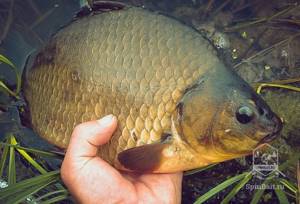
Well, the main feature of crucian carp that needs to be taken into account when fishing on a feeder: the lack of strong attachment to bait. There are often cases when one person feeds, but the neighbor starts pecking with might and main. Therefore, you should not wait for crucian carp after feeding. On the contrary, you need to look for it regularly.
Fishing in autumn
It is quite difficult to catch crucian carp at this time of year. Usually fishermen know exactly where it is found, and since in the fall there is already little food, the crucian carp is hungry and must look for food. Therefore, he will be attracted to bait made from a worm or maggot.
- At the beginning of autumn, crucian carp can be caught in places where there is a current. The activity of crucian carp increases towards noon.
- In October, the best time to catch crucian carp is from early morning to 10 and 1 hour before sunset and before dark.
- The best time to catch crucian carp in November is around noon. The rest of the time the crucian carp is inactive.
- For fishing, you should choose places 3-5 meters deep, well-warmed by the sun. In cloudy weather in autumn, crucian carp go deeper.
What does feeder tackle consist of?
Feeder equipment for crucian carp is a bottom fishing rod equipped with a feeder, which is filled with special crucian carp bait. It is the ability to organize constant feeding of fish that distinguishes the feeder from other gear used for bottom fishing. The feeder is equipped with the following main elements:
Feeder fishing rod
Equipping a feeder for crucian carp fishing begins with the choice of a rod, which depends both on the possible casting distance and on the fishing conditions. For fishing in reservoirs with standing water, a fishing rod with a test load of about 20-40 grams and a length of about 3 meters is suitable. If you are planning river fishing, you should use a rod with 80-120 grams of dough, up to 4 meters long. In any case, it must be durable, you never know what kind of trophy you might get on the hook.
Coil
After choosing a fishing rod, depending on its class, you need to select a reel. Feeders with light weight are equipped with spinning reels with a clip size ranging from 2500 to 3000. Medium or heavy rods can be equipped with a reel of 4 thousand. An important part of the reel is the friction brake.
Feeder
This element can be safely called the main attribute of equipment for feeder fishing for crucian carp. The feeder is a cage, usually metal, and can be made in different shapes and sizes. Its weight varies between 20-70 grams and is selected depending on the intensity of the current: the stronger the current, the greater the weight. Otherwise, the feeder may be carried far away from the fishing spot. However, an important condition when choosing the weight of the feeder is that it, together with complementary foods, should not be larger than the test of the rod.
In conditions of reservoirs with stagnant water, as well as when crucian carp is caught with a feeder on a muddy bottom, lighter feeders are used. Then they will not be able to dive deep into the mud, where they are unlikely to be noticed by fish.
fishing line
As the main line, both monofilament line 0.2 - 0.3 mm and braided cord 0.12 - 0.14 mm are used. The choice will depend both on the characteristics of the reservoirs and on the fishing technique. For long casts, braid is better suited, as it more accurately transfers bites to the end of the feeder rod. However, in the case of a reservoir with a rocky bottom and a lot of snags, it is better to take a monofilament fishing line that has greater elongation. It is also best suited for casting over short distances. In addition, the fishing line dampens crucian carp jerks much better.
Hooks and leash
For the leash, a monofilament line with a length of ten centimeters to one meter is used. The choice of fishing line thickness depends on the expected size of the fish and the bottom topography. For crucian carp, a fishing line diameter in the range of 0.12mm – 0.16mm is suitable. Hooks for the feeder for crucian carp must be reliable and well sharpened. The size is selected in accordance with the bait used - hooks No. 14-No. 12 are needed for bloodworms or maggots, and hooks No. 8-No. 4 are suitable for bait such as worms.
Stand
Many anglers install a feeder on a slingshot or bush. As a result, damage occurs quite often. Purchasing a special stand for feeder equipment for crucian carp will not only help preserve the integrity of the equipment, but also the ability to use several feeders at the same time. In addition, using a stand it is much more convenient to adjust the angle of inclination of the feeder fishing rod relative to the surface of the water.
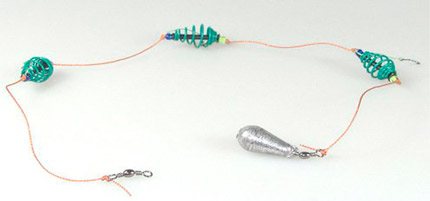
Bait for feeder for crucian carp
Compared to competitors in their natural habitat, crucian carp has advantages in terms of diet diversity and is caught on all kinds of baits. Since the natural food of this fish is insects and bottom vegetation, it is caught on:
- worms;
- maggots;
- Colorado potato beetle larva;
- burdock;
- bloodworm.
But grain and even carp boilies also show good results when hunting for crucian carp; fishermen use them as bait:
- technodough;
- bottom and floating mini-boilies;
- sweet corn;
- boiled peas;
- dough made from corn flour and semolina;
- barley;
- wheat.
In addition, feeder fishing for crucian carp will be successful using ordinary soaked bread mixed with flour or sunflower oil, so finding bait for this fish is not at all difficult at any time of the year.
Fishing for crucian carp video
Bait for crucian carp on the feeder
The right choice of bait for catching crucian carp is one of the main conditions for successful fishing. Crucian carp, of course, is not as voracious as carp, but also loves to feast on tasty treats, especially in the summer and autumn, when you have to be active and put on fat for the winter.
Purchased mixtures
In specialized retail outlets, crucian carp baits for fishing with a feeder are perhaps most widely presented in different price ranges. Choose the following baits according to:
- color;
- aromatics;
- fraction size;
- cost.
Considering the low price of store-bought crucian baits, it is not surprising that most fishermen prefer not to prepare their own.
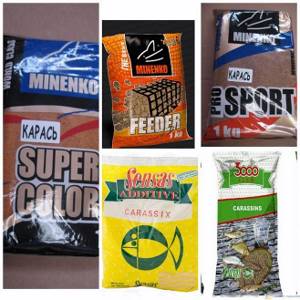
But there is no denying that experiments with bait are also encouraged, which is why homemade mixtures sometimes work better.
The most catchy baits for crucian carp fishing are baits and “Browning”, as well as domestic “Dunaev-Fadeev” or “Minenko”.
Making your own bait
Making homemade bait for a feeder or picker for crucian carp is not very difficult and all the ingredients are quite accessible; they can be bought in a store or at the market.
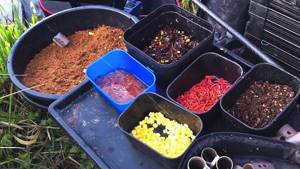
Grains and cereals are the basis of such baits; corn flakes are used as the “dusting” component; an attractive smell is provided by the addition of food flavorings.
Crucian carp is a big fan of pungent and bright smells, so it is necessary to use when making bait:
- garlic essence;
- thyme extract;
- vanillin;
- ammonia-anise drops.
Important! You should not make too “smelly” bait, because it will only scare away the fish.
Combining mixtures
Many crucian carp hunters prefer to use combinations of homemade and purchased mixtures when fishing with a feeder. This makes it possible to “play” with bait in the absence of a bite, and still interest the fish.
Moreover, we are talking not only about the aromatics, but also about the fraction of the bait, as well as its stickiness, which is not always appropriate.
When fishing with classic feeders, the bait should be rather crumbly, and it should be made sticky only when fishing in the current.
At the same time, it is difficult to make a homemade mixture completely crumbly and dusty, and adding a store-bought mixture can solve this problem.
Having store-bought bait in stock, you can always make a mixture with “homemade” bait of the desired fraction and aromatics, so this reserve should be used to the fullest.
Where to cast?
Crucian carp lives both in flowing rivers and in standing reservoirs. This is the most unpretentious fish, capable of surviving where others could not dream of doing so. The main difference from others is the need for a minimum amount of oxygen, so it gets along even in pressed-in reservoirs and ponds.
The main habitats are the border with vegetation, dumps and shallow holes. In the spring, he wakes up one of the first, starting to peck sluggishly and uncertainly. After a long winter, he is hungry and greedily takes everything he can get his hands on. Food preferences change often, but delicacies remain unchanged: barley, semolina and worms.
On the river with the current
On a large river, especially an unfamiliar one, finding a silverfish is difficult, but possible. For such places we recommend using several feeders. Each one is thrown into its own promising place, having a certain bait on the hook. After observations, it will become clear where the fish is now standing and what it is feeding on. First of all, fish dumps and borders with vegetation, not far from the shore.
Promising places for casting a feeder:
- Calm areas of water
- Border of vegetation (reeds, water lilies, algae)
- Snags and flooded bushes
- Entry and exit from the pit
- Bays with aquatic vegetation and a depth of 0.5-3 meters
The favorite places of crucian carp are warm and calm water, with depths of up to 3 meters, preferably with vegetation. During the day it stays where there is food supply. If it is not detected, it goes to the next point. Its route, regardless of whether there is a current or not, is always approximately the same. If you fish the same river frequently, you will notice trends and have an idea of where to look for it depending on the time of day.
Lakes, reservoirs, quarries with standing water
The search rules are similar to the previous paragraph. Lakes and reservoirs have clean water and strong depth changes are possible. Large crucian carp can be found at 5 meters, but more often schools stand close to the shore near vegetation. When fishing with a feeder, it is not necessary to make long casts.
It is much more promising to look for bottom irregularities close up. It is worth noting that the fishing distance can be increased if the weather is sultry and hot. Warming up the shallow water creates not very favorable conditions, so it stays away in small holes.
On the ponds
Ponds for the most part do not differ in relief, having a flat bottom. Crucian carp is the most common fish in such places due to its unpretentiousness. Walks in packs, constantly searching for food. If there is grass, fish this area first. You can safely feed a promising place; this will attract fish and keep it at the point.
In places with a clay bottom, it often comes out to feed at night, so fishing during this period gives good results. If there are no bites along the vegetation, look for a small hole and try to fish it, perhaps today the flock is standing there.
Technique
Catching crucian carp on a feeder has a lot of subtleties, tricks and secrets. But the most important step is still the correct choice of fishing spot. It is best to start searching for fish in the coastal areas of the reservoir, and if it is not there, then move away from the shore. But don’t play around, casting too far won’t lead to anything good. If there is no crucian carp in the middle of the pond, then there is no need to look further
.
Very often anglers make a big mistake when choosing a hook; take hooks as small as possible
. Large hooks will only scare away the fish, and if a worm or maggot is used as bait, then you will not be able to put it on a large hook at all.
Crucian carp is quite cautious, and everyone knows about it. If you use a large hook, the fish will try the bait for a very long time and may simply move away from it, suspecting something is wrong. But crucian carp swallow small hooks instantly.
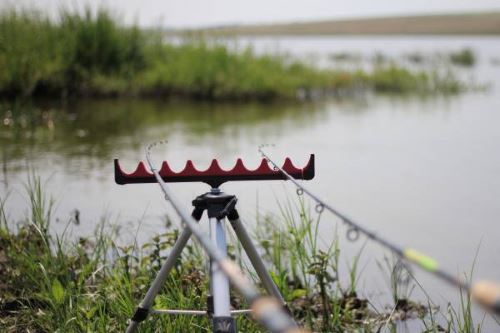
at night is very popular among fishermen.
. At night, he prefers to come closer to the shore to feed, and also stands near ravines and holes. For fishing in such conditions, you do not need a heavy feeder, since there is no need for long casting.
In order not to scare away the fish from the fishing spot and not to create unnecessary noise when casting, it is best to purchase a light rod. If you fish close to the shore, it is better to additionally feed the fish with your hands. Be sure to use loose bait for additional feeding. This structure of the bait will crumble immediately when it falls into the water and will very well attract crucian carp from all over the reservoir and keep it at the fishing spot.
Crucian carp are quite shy, so you should choose a flashlight for fishing very carefully. Try to put the bait as far from the shore as possible, and it is better to observe the rods without lighting at all (use light bite alarms).
I almost forgot, where would we be without a video about this wonderful fishing, in which they will reveal several rather interesting secrets and provide practical advice.
How to assemble equipment. Types of gear for catching crucian carp
The search for the best installation of a feeder for fastidious crucian carp is not justified. There is no one stable working option. It is recommended to select equipment based on the activity of the fish, taking into account the season and conditions of the reservoir.
The main types of rigs are borrowed from carp fishing under certain conditions of fish behavior. Some are designed for passive biting, others are designed for sports competitions and are aimed at operational fishing.
Equipment with anti-twist
Simple installation by threading the fishing line through a plastic tube bent at an obtuse angle so that the sides are of different lengths. The feeder is attached directly to the tube. The long side is closest to the hook. The design prevents the leash from tangling with the main cord and is used for passive biting. Ready-made equipment can be purchased together with a rectangular feeder.
Experienced fishermen criticize the equipment for its shortcomings:
- frequent breakdowns of the anti-twist;
- distant location of the leash, which slows down the reaction to bites.
The equipment is often used by novice fishermen.

Schematic version
Asymmetrical loop
An installation that is more sensitive to bites is used when crucian carp activity is low and is used in conjunction with a mesh feeder. High bite transmission occurs due to the short arm. You need to tie a fishing line with a carabiner at the end in a loop measuring 40-45 cm. The design is distinguished by fastening the cage at the maximum permissible level. Below the feeder, a second loop is made in a figure eight, and a leash is attached to it. It is better to construct it from a rigid fishing line to reduce the risk of overlapping.
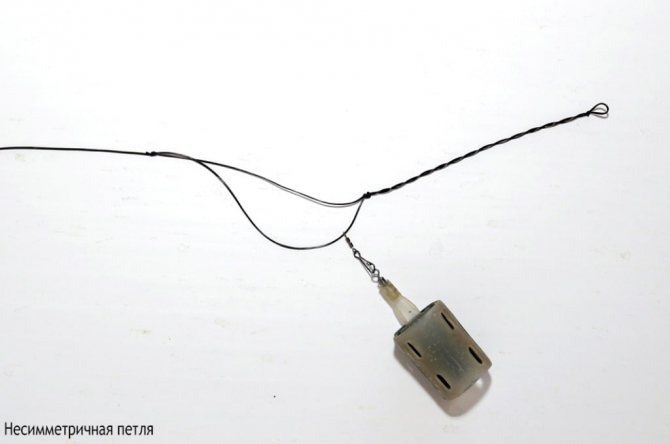
Sensitive equipment
Paternoster type equipment
Installation of this type involves mounting the feeder on a rigid outlet. Used for confident bites. Rigs that are considered rough are self-cutting rigs. Various feeder options are available.
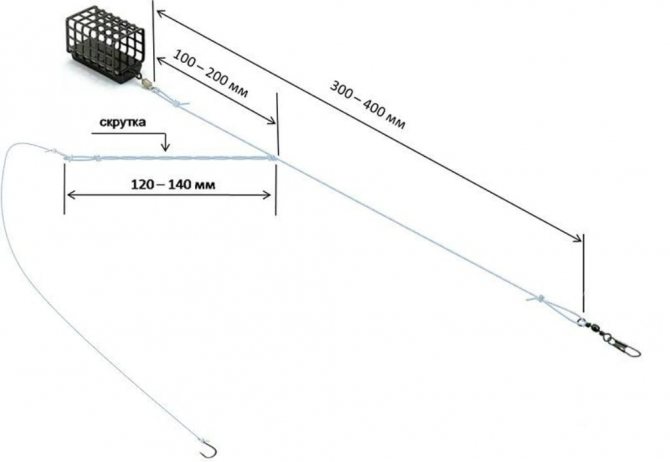
Schematic view
Symmetrical loop
Self-locking equipment is universal for reservoirs with unknown topography and is highly sensitive. The manufacturing scheme is simple. The main line at the end is folded in half (45-50 cm), a loop 3 cm in size is constructed. The sliding cage is attached to one side of the symmetrical loop. You can fish in reservoirs with muddy or hard bottoms. Catching crucian carp with this type of equipment is successful even with sluggish bites.
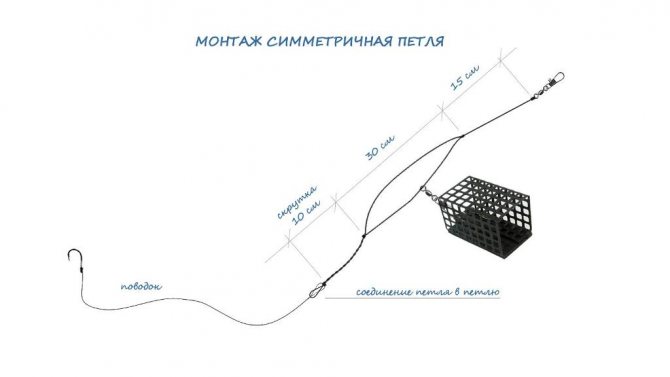
Installation with dimensions
crucian carp killer
The equipment includes a garland of spring feeders (usually 3 pieces) mounted on one cord. Separate leashes are mounted to each feeder, hooks with bait are pressed into the bait, which is filled with springs. The equipment is self-locking. The composition of complementary food determines the success of fishing.
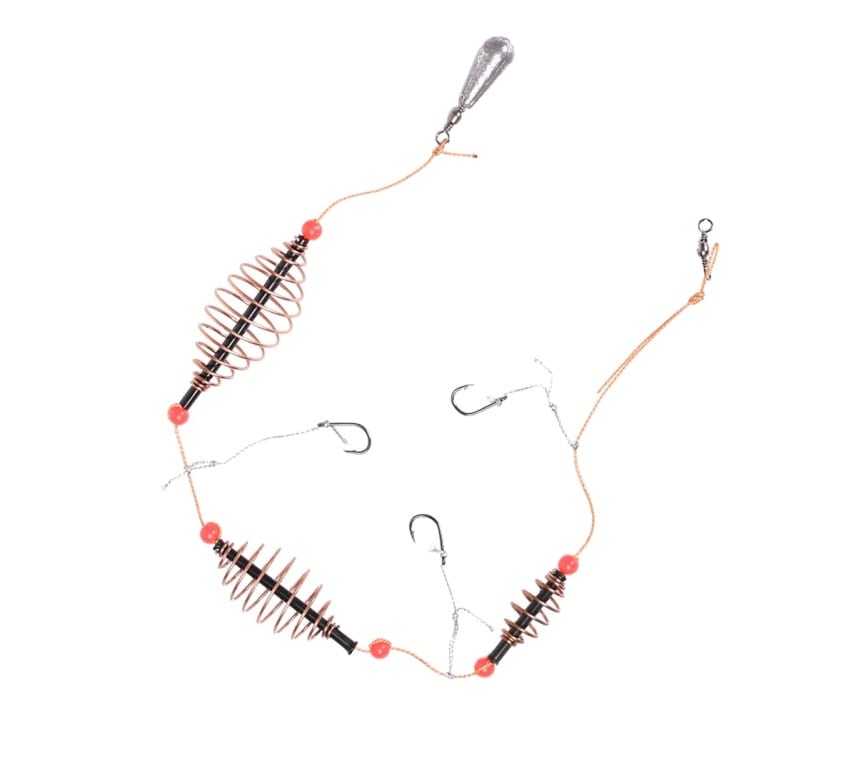
Three spring installation
Fishing methods
Usually crucian carp are caught in the summer using bottom and float gear. At the same time, in some reservoirs it bites better on the bottom, and in others on the float. The method of fishing itself matters only to the angler; for crucian carp, the main biting factor is the bait, bait and fishing location.
For example, in heavily overgrown reservoirs, in windows of aquatic vegetation, where the bottom is densely covered with thickets of hornwort, it is not possible to fish with a bottom. On the contrary, where the bottom is relatively clean, level, without snags, and the crucian carp does not want to come close to the shore, fishing with bottom gear will be more convenient and will bring better results.
Self-catchers are often used. This is due to the fact that in an unfamiliar body of water it is difficult to reliably determine the time when fish enter a certain place. Therefore, they try to cover a fairly large coastline by installing self-propelled gear. Crucian carp has fairly constant habits. When the time and place of exit have been determined, it is much more effective to switch from self-catching to active gear in this area.
Flying float rod
Tackle No. 1 for crucian carp. Since this fish often prefers coastal areas, there is usually no need to cast long distances or use a reel. You can get by with a light and relatively inexpensive fly fishing rod, which consists of a rod with a fishing line rigidly attached to its tip, equipped with a float and a hook.
A fly rod can be used of various lengths, but for catching crucian carp it is better to use a rod of 4-6 meters. Longer ones will require constant use of stands, since it will be difficult to hold them in your hands all the time. However, when fishing for crucian carp, the use of rod stands is not a problem, since they are caught using a standing rig. In still water, 2-3 rods are most often used, cast at different distances from the shore, and different baits are used. This significantly increases the chances of a fish biting. It is the ability to fish from stands that makes a fly rod the best choice; even with a large, heavy rod, the angler will not get tired and you can use several tackles.
The main advantage of a fly fishing rod is that it allows you to cast the equipment very accurately, perform high-quality hooking, use thinner fishing line and, as a result, a lighter float with less load under the same fishing conditions. Fishing in windows, fishing with the lightest possible tackle, fishing with a very precise release of the fishing line, allowing you to clearly place the bait on the bottom vegetation carpet, allows you to achieve better results when fishing for crucian carp using a fly rod than when fishing with other gear.
Match fishing rod
Not a very popular tackle, and completely in vain! In terms of cost, such fishing is not much more expensive than feeder fishing. However, for crucian carp places, match fishing is preferable. It allows you to cast the tackle quite accurately, fish on a very snagged or overgrown bottom, and fish in cluttered urban and suburban ponds, where when fishing with bottom gear there will be a lot of snags and cliffs.
At the same time, a match fishing rod allows you to fish distant sectors from the shore. Using modern match pop-up floats and equipment, you can clearly see the bite at a great distance from the shore, and keep the float from being displaced by the wind with the help of a system of catches lying on the bottom.
You can successfully cast into large windows at a distance from the shore, and when you pull out fish, you collect much less grass than would be the case with bottom tackle.
Bolognese fishing rod
Not so often used for catching crucian carp. Such a tackle is fully revealed only in the current, where it is quite rarely caught. But sometimes, when catching silver crucian carp in the channels, it is the lapdog that becomes the best choice. Typically, a Bolognese fishing rod for crucian carp is used in still water, where they want to cast long distances from the shore. At the same time, it significantly loses in the convenience of fishing, and in the range, and in the accuracy of casting, to a match fishing rod. And when fishing from the shore without casting with a reel, the tackle will be much heavier and rougher than a fly rod with the same capabilities. However, if there is no other fishing rod, Bolognese tackle will do.
Donka
Bottom fishing for crucian carp works best in the late period, with the onset of cold weather. At this time, aquatic vegetation dies off, the donka will carry less grass. Usually in the summer, along with the fish, half a pound of water stems are also pulled out. Therefore, the tackle must be strong enough to withstand all this. A cheap fiberglass spinning rod is used as a fishing rod in a “Soviet” style donk, an inexpensive inertial reel is installed, a fairly thick main line is used, and, as a rule, they are caught without a feeder. The tackle is very simple, but it has many disadvantages that other bottom tackle - a feeder - lacks.
Much more often, instead of a donkey with a rod, a type of hook is used - fishing for crucian carp with an elastic band. An elastic band is a bottom in which there is an elastic band 3-10 meters long between the main line with hooks and sinkers. This makes it easier to re-throw the tackle during frequent bites and always return the hooks to the same place. Of course, the fishing distance will be shorter. But when fishing for crucian carp, long casting is rarely required.
Feeder and picker
They are a further development of the bottom fishing rod, more modern and convenient. The main features of these tackles are the use of a special flexible tip as a bite alarm. They allow you to cast more accurately and farther with a lighter load, which is essential when fishing among grass. Ultimately, a tackle with a light sinker will collect less of it. Both fishing line and cord are used, and fishing line for crucian carp will be preferable.
Fishing usually takes place at shallow depths, a short distance from the shore. Catching crucian carp with a picker, a type of feeder, allows you to get more pleasure from pulling out fish with thinner and lighter tackle. In addition, the picker itself will be much more convenient in such conditions, since the shore is often overgrown with bushes and trees.
Very often, when fishing for crucian carp, a flat feeder weight is used. The carp feeder of the “method” type sinks less into the silt and releases food on its surface better than the classic feeder “cage”. But at the same time, it is more demanding on the quality of bait and mixing. A banjo-type feeder allows you to catch aquatic plants even from a carpet, when the load is not immersed in its thickness. Quite often when catching crucian carp, the hooks remain in the bait to give fewer hooks. The same principle is implemented in the “nipple” fishing gear.
"Cork", "pacifier", "phantomas"
All these names refer to self-catching gear, when hooks with bait on leashes are immersed in a feeder weight filled with bait and completely open on one side. In this case, leashes are usually tied to the sinker itself. And it is attached to a fishing line and cast at a distance from the shore. Thus, the hooks are almost completely protected from snagging on algae.
Crucian carp, approaching the feeder and eating food, can in the process also pull in the hooks, getting caught by them. Therefore, they will not get caught even when the bait is eaten - after all, fish will sit on them.
The main disadvantage of such gear is that you need to use the smallest hooks, almost swallowed. This leads to the fact that the main prey will be small fish, since it will feel a large hook and spit it out, because the tackle is self-catching, and there is no timely hooking here.
Also, catch-and-release fishing, or catching crucian carp with live bait, becomes impossible. The fish swallows the small hook deeply, so you have to take it all out and then fry it. It is best to make the leashes removable so that you can remove the fish from the hook at home. It is much better later, in a calm environment, to see the fishing line sticking out of the fish’s mouth, and pull it out along with the hook when gutting. Why, while fishing, pull out a hook, tear it off, forget it in the fish and then eat it yourself. Such gear cannot be seriously considered in modern fishing, since in terms of catch, fun of fishing and quality of fish it will be inferior to all other gear.
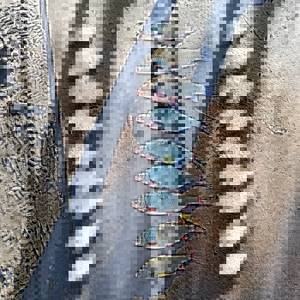
Summer jig
It is used very successfully for catching crucian carp. In the spring, when the water is cold enough, it allows you to attract fish by playing to the bait. In this case, it is best to use two jigs - one heavier, which often plays the role of just a load, and the second, lighter, is attached higher. This allows you to “slow down” the game by placing the lower jig on the bottom, since the crucian carp takes the standing bait better. Instead of the top jig, you can tie a simple hook with an attachment.
Another “specialization” of the summer jig is fishing in heavily overgrown places and windows. Here the line practically does not deviate from the vertical. Therefore, it is possible to fish even in the smallest windows, between the stems of reeds, avoiding snags. It is unlikely that you will be able to do this in other ways, except with a fly fishing rod, but there is still a higher risk of snagging or tangling the tackle.
Winter gear
Winter fishing for crucian carp is no different from fishing for roach, except that the tackle is more durable. Use a jig and a float rod. It is best to use rods that allow you to stop the game with bait and at that moment the fish bites. They are often caught with several fishing rods, using bait alternately or without playing at all.
The second group of winter gear is various self-catchers. Fishing for crucian carp on crosses and girders is popular, especially on an unfamiliar body of water, where they do not yet know the places of its most active biting. Worms are used as bait for self-catchers, sometimes vegetable baits, pellets or even dog food from bags.
You can ask your question to our author:
Feeding crucian carp depending on the type of reservoir
To fish for crucian carp using a feeder in stagnant bodies of water with dense vegetation, you will not need a lot of bait. In this case, the best option would be to use a mixture of black bread soaked in water, boiled barley and oatmeal, barely moistened with water.
But in reservoirs that are not particularly rich in algae and other aquatic plants, such as a reservoir, deep stakes or river bays, crucian carp behaves completely differently. There is quite a bit of natural food in such places, so crucian carp feed near the coastal zone in the same place at certain periods of time, and in order to keep the fish in the artificially fed fishing area, much more bait mixture will be needed.
It is important to remember that the mixture for fishing for crucian carp on a feeder should have a color very similar to the bottom of the reservoir. It should not scare away the fish with its appearance, then the crucian carp will look for food based on its sense of smell and touch. But its attractive aroma will help increase the length of stay of the crucian carp at the fishing site.
Secrets of fishing
Catching crucian carp with feeder gear is easier than fishing for carp, but it also has its own characteristics and secrets.
- Choose a free place where nothing will interfere with casting tackle with a feeder
- The crucian bite looks cautious, so the angler should react to every unusual movement of the tip
- Using a special clip allows you to make an accurate cast to one place, which sooner or later will attract a large crucian carp
- In standing water, periodically twitch the feeder to release more food.
- When combining baits, try alternating them in different sequences - at times crucian carp is absolutely unpredictable
- Throw one tackle to the depths and the second closer to the shallows to quickly understand where he is feeding now
- If you are fishing on a river, try moving downstream some time after feeding and starting fishing - fish often accumulate there
- Try casting to different areas - the crucian carp moves all the time and you will be able to determine the places of its greatest concentration
To summarize, we can call this method of catching crucian carp a good option that will diversify your fishing and give you a lot of impressions.
How to catch crucian carp in still water and in the current
Crucian carp are caught using classic feeder rigs, as well as using the method and flat method, and every feeder fan can choose the rig option that is more preferable to him.
But the specifics of the reservoir must also be taken into account, because it is not enough to know in general how to catch crucian carp on a feeder. It’s one thing to fish in still water, on a lake or at a stake, and quite another on a river, when the current quickly carries away light plastic feeders and even casting delicate equipment is much more difficult.
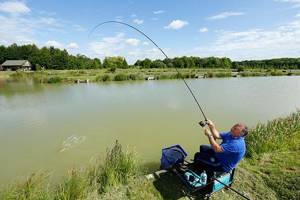
On ponds, crucian carp are caught better on a feeder, although they are less active due to the absence of a large number of predators that can pose a danger. In such situations, light picker rods or feeders up to 3.3 m long are used, since long-distance power casts are not needed.
On the river they use powerful feeder rods, which make it convenient to cast heavy feeders over a considerable distance.
It is necessary to send the equipment to the same place, so it is better to fish “under the clip”, especially since “give me the rod” bites practically never happen; mostly small fish are caught.
